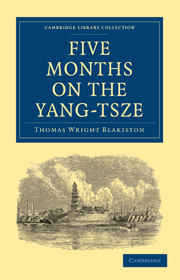 Five Months on the Yang-Tsze
Five Months on the Yang-Tsze Book contents
- Frontmatter
- PREFACE
- Contents
- LIST OF ILLUSTRATIONS
- CHAPTER I UP TO NANKING
- CHAPTER II THE MING TOMBS
- CHAPTER III THE TAIPINGS AT THEIR CAPITAL
- CHAPTER IV A NAVAL SQUADRON INLAND
- CHAPTER V ADMIRAL HOPE'S EXPLORATION
- CHAPTER VI JUNK TRAVELLING IN HOO-PEH
- CHAPTER VII SHI-SHOW TO I-CHANG
- CHAPTER VIII GORGES AND RAPIDS
- CHAPTER IX EASTERN SZ'CHUAN
- CHAPTER X VISITS AND CEREMONIES
- CHAPTER XI THE GOLD-SAND RIVER
- CHAPTER XII CROSS RANGES
- CHAPTER XIII CHUNG-KING
- CHAPTER XIV THE FOUR VALLEYS
- CHAPTER XV SÜ-CHOW AND THE WESTERN REBELS
- CHAPTER XVI PING-SHAN — OUR FARTHEST
- CHAPTER XVII THE UPPER YANG-TSZE
- CHAPTER XVIII DOWN THE KIN-CHA KIANG
- CHAPTER XIX RETURN FROM THE INTERIOR
- APPENDIX
CHAPTER XIX - RETURN FROM THE INTERIOR
Published online by Cambridge University Press: 28 April 2011
- Frontmatter
- PREFACE
- Contents
- LIST OF ILLUSTRATIONS
- CHAPTER I UP TO NANKING
- CHAPTER II THE MING TOMBS
- CHAPTER III THE TAIPINGS AT THEIR CAPITAL
- CHAPTER IV A NAVAL SQUADRON INLAND
- CHAPTER V ADMIRAL HOPE'S EXPLORATION
- CHAPTER VI JUNK TRAVELLING IN HOO-PEH
- CHAPTER VII SHI-SHOW TO I-CHANG
- CHAPTER VIII GORGES AND RAPIDS
- CHAPTER IX EASTERN SZ'CHUAN
- CHAPTER X VISITS AND CEREMONIES
- CHAPTER XI THE GOLD-SAND RIVER
- CHAPTER XII CROSS RANGES
- CHAPTER XIII CHUNG-KING
- CHAPTER XIV THE FOUR VALLEYS
- CHAPTER XV SÜ-CHOW AND THE WESTERN REBELS
- CHAPTER XVI PING-SHAN — OUR FARTHEST
- CHAPTER XVII THE UPPER YANG-TSZE
- CHAPTER XVIII DOWN THE KIN-CHA KIANG
- CHAPTER XIX RETURN FROM THE INTERIOR
- APPENDIX
Summary
The “Upper Yang-tsze Expedition,” at the close of the last chapter, had just arrived in two Sz'chuan boats at I-chang; and while they are arranging for their farther conveyance in a junk, larger and more suitable to the placid waters of the lower portion of the “Great River,” I will say a word or two on I-chang.
Eleven hundred statute miles up the Yang-tsze Kiang, at a point where, after coursing the fertile province of Sz'chuan, and breaking through a rugged mountainous region, that river emerges into the great plain of Hoo-peh, the situation of I-chang is one of the most important on the great highway of Middle China. Easily accessible to large steamers at all seasons of the year, and at the portal, as it were, of the more unmanageable upper waters, I-chang, when European traders push their commerce more into the western country, will probably become a great place of business as a port of transshipment. A slight alteration in “Article X.” of the “Treaty of Tien-tsin,” with regard to the distance to which British vessels may trade on the Yang-tsze, would encourage the building of steamers for the navigation of its upper waters, and cause another European settlement to spring up at this point, which, to say nothing of the advantages of trade, and its being the limit to which ordinary steamers can ascend, would, as a healthy and agreeable location, stand unrivalled.
- Type
- Chapter
- Information
- Five Months on the Yang-TszeWith a Narrative of the Exploration of its Upper Waters and Notices of the Present Rebellions in China, pp. 326 - 350Publisher: Cambridge University PressPrint publication year: 2010First published in: 1862


